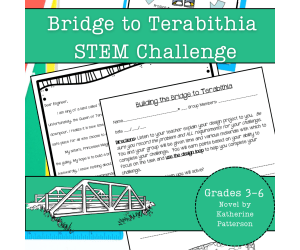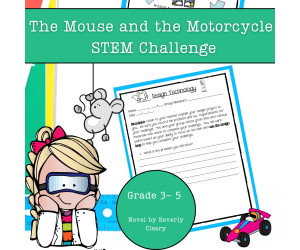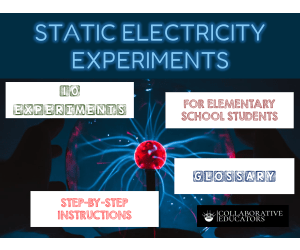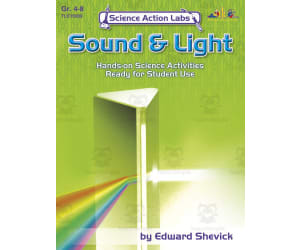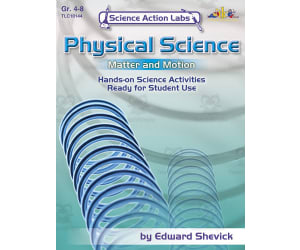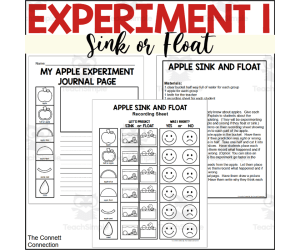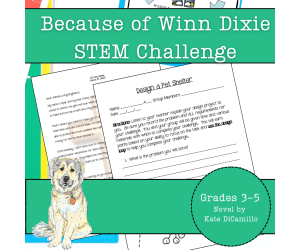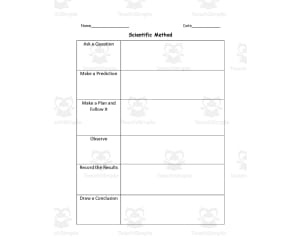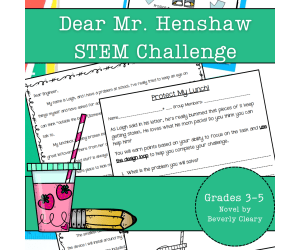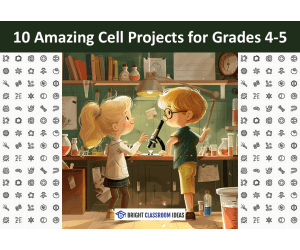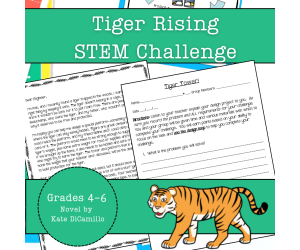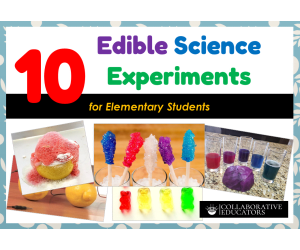2,741 products added recently
Fun Science Experiments For Kids
Make science exciting for young learners with fun experiments that encourage hands-on exploration. This collection includes activities like growing crystals, making homemade lava lamps, and exploring magnetic fields. By integrating these experiments into your lessons, you can foster a love for science and encourage inquisitive thinking.
Bridge to Terabithia STEM Experiment + STEM Project for Grades 4, 5, 6
Science, Technology, Engineering, STEM, Grade 4, 5, 6, Experiments, Activities, Projects, Diagrams, Teacher Tools, Graphic Organizers, Rubrics
Bring literature to life with this exciting STEM activity inspired by Bridge to Terabithia! This challenge sparks creativity and problem-solving as students plan and construct a bridge for King Jesse as he plans to make entrance to Terabithia safer. Perfect for blending literature with science, it allows students to explore engineering concepts using simple supplies while promoting teamwork and critical thinking. What’s Inside This Resource: Student Letter: A letter from Jesse introduces the challenge, linking the story to a real-world engineering task. Design Loop Graphic: A visual students can attach to their science journals, serving as a step-by-step guide throughout the activity. Detailed Instructions: Choose to print the guide as a packet or have students record each stage in their journals for an interactive experience. Teacher Tips: Practical guidance for crafting a clear problem statement with time constraints, materials, and success criteria tailored to your classroom. Skills Your Students Will Build: ✔ Problem-Solving: Identify obstacles and create inventive solutions. ✔ Engineering Design: Navigate the design loop—plan, construct, test, and refine. This page can easily be enlarged for a classroom poster. ✔ Critical Thinking: Assess their prototype’s performance and pinpoint ways to enhance it. ✔ Teamwork: Collaborate effectively to accomplish shared goals. Versatile Classroom Application: Whether as guided instruction or part of an integrated literature and science unit, this STEM activity encourages students to think creatively, document their process, and meet science and engineering standards. The rubric included is based on engineering concepts, but can also be used as a nonfiction writing rubric for cross-curricular options. Why Educators Love This Resource: ⭐ “My students were fully engaged, combining their passion for reading with STEM!” ⭐ “Simple to set up and encourages creativity and teamwork.” ⭐ “A seamless connection between literature and science for cross-curricular learning!” Empower your students to solve Jesse’s challenge and experience the excitement of engineering with this standards-aligned STEM adventure!
Author Kel's Klass
Tags 4th Grade Science Project, 4th Grade Science Experiment, 5th Grade Science Project, 5th Grade Science Experiment, 6th Grade Science Project, 6th Grade Science Experiment, Engineering Diagram, Science Graphic Organizer, Science Rubric, Bridge To Terabithia
The Mouse and the Motorcycle STEM Experiment + STEM Project
Science, Technology, Engineering, STEM, Grade 3, 4, 5, Experiments, Activities, Projects, Diagrams, Teacher Tools, Graphic Organizers, Rubrics
Help design and build a four-wheeled car for Ralph, the adventurous mouse, from The Mouse and the Motorcycle. Perfect for integrating literature and science, this challenge guides students to apply engineering principles using simple materials while fostering teamwork and critical thinking. What’s Inside This Resource: Student Letter: A fun letter from Ralph introduces the challenge, linking the story to a real-world engineering task. Design Loop Graphic: A visual students can attach to their science journals, serving as a step-by-step guide throughout the activity. Detailed Instructions: Choose to print the guide as a packet or have students record each stage in their journals for an interactive experience. Teacher Tips: Practical guidance for crafting a clear problem statement with time constraints, materials, and success criteria tailored to your classroom. Skills Your Students Will Build: ✔ Problem-Solving: Identify obstacles and create inventive solutions. ✔ Engineering Design: Navigate the design loop—plan, construct, test, and refine. This page can easily be enlarged for a classroom poster. ✔ Critical Thinking: Assess their prototype’s performance and pinpoint ways to enhance it. ✔ Teamwork: Collaborate effectively to accomplish shared goals. Versatile Classroom Application: Whether as guided instruction or part of an integrated literature and science unit, this STEM activity encourages students to think creatively, document their process, and meet science and engineering standards. The rubric included is based on engineering concepts, but can also be used as a nonfiction writing rubric for cross-curricular options. Why Educators Love This Resource: ⭐ “My students were fully engaged, combining their passion for reading with STEM!” ⭐ “Simple to set up and encourages creativity and teamwork.” ⭐ “A seamless connection between literature and science for cross-curricular learning!” Inspire your students to solve Ralph’s problem and discover the joy of engineering with this fun, standards-aligned STEM challenge!
Author Kel's Klass
Tags 4th Grade Science Project, 4th Grade Science Experiment, 5th Grade Science Project, 5th Grade Science Experiment, Engineering Diagram, Science Graphic Organizer, Science Rubric, 3rd Grade Science Project, 3rd Grade Science Experiment, The Mouse And The Motorcycle
Static Electricity Experiments for Elementary School
Physics, Science, Grade 1, 2, 3, 4, 5, Labs, Experiments, Activities
What is electrostatics, or static electricity? The buildup of electric charge on an object's surface is called static electricity, or electrostatics. This charge, which can be either positive or negative, is produced when a material's atoms acquire or lose electrons. When two objects rub against one another, electrons are transferred from one to the other, creating this static energy. As a result, one of the materials has a negative charge due to an excess of electrons, while the other material has a positive charge due to a lack of electrons. The feeling of a tiny electric shock after stepping on a rug and then contacting a metal surface is a typical example. Ten extremely basic and doable experiments that use or create static electricity are included in this useful e-book. Every experiment is safe and may be carried out using normal, commonplace items. Every experiment has comprehensive, step-by-step instructions. Lastly, each experiment is given a brief explanation so that elementary school pupils can understand it. Have fun exploring the marvels of static electricity through experimentation!
Author Bright Classroom Ideas Marketplace
Rating
Tags Static, Electricity, Experiment, Elementary, Science, Physics
Water Cycle Earth Science Activity
Earth and Environmental Sciences, Science, Earth Sciences, Environmental Science, Grade 2, 3, 4, Experiments, Activities, Diagrams, Teacher Tools, Lesson Plans, Templates
I created this water cycle science activity for young students who are beginning to learn how water moves through Earth’s systems. Each page focuses on a simple part of the water cycle, including evaporation, condensation, precipitation, and collection. The worksheets include clear diagrams, short explanations, and guided activities so students can understand the concept without feeling overwhelmed. This type of activity works well during science lessons, especially when students are being introduced to Earth science topics. It can be used as a whole-class activity, a science center, morning work, or extra practice after a lesson. I’ve used similar worksheets before, and students enjoy labeling diagrams and following the steps of the water cycle from start to finish. The pack is easy to print and works well in both color and black-and-white. It fits nicely into classroom routines and can also be used at home for review or reinforcement. What’s included: 11 printable water cycle worksheets Clear and simple water cycle diagrams Activities covering evaporation, condensation, precipitation, and collection Kid-friendly science illustrations Suitable for grades 1–3 Great for individual, partner, or small-group work
Author Bright Education
Rating
Tags Science, Water Cycle, Earth Science
Science Action Labs Sound & Light
Science, Physics, Grade 4, 5, 6, 7, 8, Labs, Experiments, Activities
Science Action Labs Sound & Light An exceptional educational resource aimed especially at students in Grades 4-8, focusing predominantly on engaging physical science subtopics. This easy-to-use workbook captivates the minds of budding learners, stimulating their imagination and curiosity through hands-on experience with sound and light concepts. Participatory learning is favored over mere observation. Students engage in entertaining experiments using commonplace objects like mirrors and flashlights to unpack complex scientific principles in a digestible manner. By interacting with sound waves and light as reflected or emitted from these objects, young minds gain better comprehension of scientific theories. Sir Isaac Newton's wisdom is celebrated throughout the pages of this book. Simplified explanations grounded in his concepts build understanding while additional nuggets of information further enrich knowledge, fostering a lighthearted yet potent educational environment for the pupils. Encouragement is key — plentiful doses are offered while confidently guiding learners on their journey. Versatile Usage The Science Action Labs Sound & Light primarily serves classroom usage during whole-group instruction, but also can work effectively for smaller group engagement - such as after-school science clubs or other similar activities. It even supports homeschooling parents looking to reinforced their current curriculum effectively. Instructor’s Asset For added convenience, this tool includes a single manageable PDF file containing 64 print-ready pages formatted for standard paper sizes . This becomes ideal when preparing assignments or practical sessions need to be straightforward! Besides serving as worksheets that underpin knowledge gained during teaching sessions, these materials could also support homework assignments; thus linking school-based learning into home-time follow-up tuning perfectly. In Summary: The Science Action Labs Sound & Light translates abstract scientific theories into tangible understanding via active tasks. Because truly, nothing embeds learning quite like doing!
Author Classroom Complete Press
Tags Action Labs, Science Labs, Sound, Light, Science Worksheet
Science Action Labs Earth Science
Science, Earth and Environmental Sciences, Earth Sciences, Grade 1, 2, 3, Labs, Experiments, Activities
Science Action Labs Earth Science A practical teaching resource, Science Action Labs Earth Science, aims to stimulate the natural curiosity of young learners and expose them to the marvels of our planet. It emphasizes exploration and discovery through hands-on activities that deepen 1st to 3rd graders' understanding of Earth science concepts. About The Resource: The material encompasses 64 printable PDF pages. The pages are rich with diverse experiments and activities focusing on key subjects such as continents, earthquakes, Earth's air, water, soil as well as its motion and layers. The flexibility of these activities is extensive. You can either carry out whole group sessions or assign small group tasks each with distinct exercises that foster teamwork and creativity among students. Bonus Feature: The added review quizzes serve as effective tools for progress assessment letting educators evaluate student comprehension levels on newly learnt topics with ease. Versatile Application: This educational tool’s versatility makes it perfect for structured class lessons or homework assignments while also offering potential enhancements to an existing earth science curriculum. Its flexible usage fosters increased engagement levels leading to improved academic performance over time. Ease Of Access: You can readily access this resource kit in PDF format which offers convenient dissemination without compromising quality. In Summation... This pragmatic approach offered by our earth science exploration kit bridges knowledge acquisition with actual hands-on experiences delivering a holistic learning journey. This integrated learning experience could spark potential Geologists or Meteorologists within your class paving the way towards creating scientific explorers one lab activity at a time.
Author Classroom Complete Press
Tags Science Labs, Earth Sciences, Art Challenge, Flying Into Space, Moon Facts
Apple Science Experiment - Observing Apples
Fall, Seasons, Holiday & Seasonal, Basic Science, Science, Nature & Plants, Life Sciences, Kindergarten, Preschool, Grade 1, 2, Experiments, Activities
Make learning about apples fun with this apple science experiment. Students will practice making predictions, conducting an experiment, and recording their results with this apple observation experiment. What is Included: There is a detailed instructional page that provides detailed instructions for the experiment, a materials list needed, and any special tips or optional activities to complete with this experiment. There is a recording page with easy to follow directions for students to draw or color their predictions and record the results of the experiment. There are two journaling pages students can use to record their results and write about what they observed during the experiment. One journal page includes picture clues to guide students in their responses, while the other is a simple journal page for students to draw whatever they wish and then write their responses. What is the Experiment? This experiment is an apple observation. An apple will be cut into fourths and placed in different environments for students to observe what happens to the apple slices after a set period of time. This experiment allows students to observe the oxidation process in an apple. How to Use: Students can work in small groups of 2 or 3 to complete this experiment. The teacher may also choose to lead the experiment with the whole group of students. Each method allows students to make predictions and record results on their own. This science experiment is perfect for young learners. The easy to follow instructions and scaffolded recording and journaling pages help students through completing the experiment. While setting up the experiment does take material and time to do, the recording pages and journaling pages are no-prep, making this an easy activity to prepare for students. The low prep experiment is a great addition to any busy classroom or home school environment.
Author The Connett Connection
Rating
Tags Apple Science, Apple Science Experiments, Science Experiment, Elementary Science, 1st Grade Science Experiments, Kindergarten Experiments, Kindergarten Science Projects, Science Experiments For Kids
Photosynthesis Lesson and Experiment for 3rd and 4th Grade Science
Science, Nature & Plants, Life Sciences, Earth and Environmental Sciences, Earth Sciences, Grade 3, 4, 5, Centers, Activities, Labs, Experiments, Worksheets, Worksheets & Printables
Photosynthesis Lesson, Worksheets, and Experiment How Plants Make Food - 3rd & 4th Grade Science Lesson I created this resource to give students a clear and enjoyable introduction to photosynthesis. The lesson blends reading, discussion, and a hands-on experiment so students can see how plants make their own food in a way that feels real and meaningful. I put this resource together because photosynthesis is one of those topics that becomes much easier to understand when students can read about it and observe it in action. This set offers a mix of activities that help students explore the idea from different angles. What’s inside? A short reading passage that explains photosynthesis Seven comprehension questions with an answer key A step by step experiment using black gram seeds Follow-up discussion questions to guide class conversation Safety notes and cautions for the experiment Two anchor charts that break the process into small pieces A quick True/False activity with answers A diagram activity where students label the photosynthesis process A story-writing page where students write from the point of view of a plant Complete answer keys to all the questions are included in this resource Resource features: I designed this set with 3rd and 4th graders in my mind. The reading level and activities are approachable for that age group. The experiment inside the resource is simple enough for students to complete in small groups, but still gives them something meaningful to observe. I have written all the instructions clearly. Each activity in this resource builds on the previous one so students can connect ideas as they go. This resource also blends science with literacy, drawing, and creative thinking, which makes it easy to fit into a variety of lesson plans or science centers. Ways to use it: Reading activity: Have students read the passage and answer the questions independently or with partners. Vocabulary work: Create a small word wall or glossary for science terms. Hands-on learning: Set up the seed experiment as a class or rotate it through small groups. Science journals: Encourage students to record their predictions and observations throughout the experiment. Art activity: Students can draw and label the parts of a plant involved in photosynthesis. Writing prompt: Let students write a short story from the perspective of a plant creating its own food. Group talk: Compare observations, discuss results, and talk through what might have caused them. Extensions: Students can look at different types of plants and explore how sunlight and environment affect their growth. Usefulness for teachers, homeschoolers, and parents This resource works well as a mini-unit as it requires very little preparation. The activities give students different ways to understand the process of photosynthesis. This resource is suitable for a wide range of learners. It supports reading comprehension, science vocabulary, and basic scientific inquiry skills, all while keeping instructions simple enough for independent use. The experiment uses easy to find materials, and the activities make it simple to incorporate science into home learning or family projects. photosynthesis, 3rd grade science, 4th grade science, anecdotal activity, photosynthesis story, hands-on learning, plant science, reading comprehension, science experiments, STEM, elementary education, homeschool science, nature study, scientific inquiry, vocabulary building, cross-curricular learning, environmental education, chlorophyll experiment, plant growth, science journaling, critical thinking, observation skills, teaching resource, environmental science, anchor charts, photosynthesis experiment
Author FlashKart
Rating
Tags Science, Photosynthesis, Plants, 3rd Grade Science, 4th Grade Science, Photosynthesis Experiment, Science Reading, Sunlight, Science Process, Earth Science
Science Action Labs Physical Science: Matter and Motion
Science, Physics, Grade 4, 5, 6, 7, 8, Labs, Experiments, Activities
Science Action Labs Physical Science: Matter and Motion An essential teaching resource designed for educators of Grade 4 to Grade 8 students with a primary focus on Newton's First Law of Motion. This versatile science guide forms the foundation for a range of engaging activities. Lessons grounded in physical science, revolving around essentials such as matter and motion. Characteristics of matter, friction integration and understanding concept made effortless with this pragmatic resource. Actionable Labs The many engaging projects include: Building simple pendulums. Creating miniature scenarios to demonstrate overcoming friction. The activities introduce novel methods to explore conventional concepts through active learning. This affluence in implementation strategies meets varying teaching needs from whole group instruction to individual assignments based on the class or student requirements. Ease of Use The constructively organized PDF entails: A ready-to-print format containing 64 straightforward pages - easing preparation time with well-designed activities available at your fingertips! To summarize,, "Science Action Labs : Physical Science - Matter And Motion" strikes an effective balance between theory and practice cultivating an active learning environment for conceptual mastery via real-world application focused hands-on activities.
Author Classroom Complete Press
Tags Hands-on Science, Edible Atoms, Mousetrap Science, Momentum Challenge, Inertia
Science Action Labs Insects: Hands-On Science Activities Ready for Student Use
Science, Life Sciences, Insects, Grade 1, 2, 3, Labs, Experiments, Activities
Science Action Labs Insects: Hands-On Science Activities Ready for Student Use This interactive science activity kit offers a riveting method of teaching elementary students, specifically those in grades 1 through 3, about the fascinating world of insects. This comprehensive resource unravels various aspects about different insects and their life cycles under a simple yet informative light. Dynamic Learning Experience The unique experience integrates demonstrations and experiments into lessons. Activites include: Writing poetry about bugs Holding grasshopper jumping contests Constructing honeycombs from scratch Guide characters C.D., Allie, and Orbit are presented throughout for systematic knowledge acquisition that renders comprehension easier for young learners. A Teacher-Friendly Resource with Different Implementations This rich-resource comes packed with 64 printable pages tailored to beginner scientists' needs. It's an excellent tool for educators introducing insects at primary grade level either through individual study or group studies within classrooms. The buzzing environment at our feet opens up wonders beyond any storybook ever could relay about mother nature's intricate designs. Truly, the learning journey into the insect kingdom ties closely with fun for enhanced learner engagement together with Science Action Labs Insects teachings on these vital players in nature's ecological dance.</p
Author Classroom Complete Press
Tags Science Action Lab, Insects, Hands-on, Science Activities
Fun with Chemistry: 20 Exciting Chemical Reaction Experiments For Kids
Chemistry, Science, Elementary, Experiments, Activities
Welcome, young scientists and teachers! This eBook is full of fun and colorful experiments that show how different substances can react to create amazing effects. You will see bubbles, color changes, fizzing eruptions, and even “rockets” that zoom up into the air. As you explore these experiments, remember that science is all about asking questions, observing closely, and having fun learning about the world around us. There are 20 exciting chemistry experiments included. They all involve simple chemical reactions that can be safely performed by kids. For each experiment, the materials are listed, and the step-by-step procedure. Finally, an explanation is given, so as to highlight the science behind the experiment. Last but not least: All experiments must be conducted under strict adult supervision. Always wear safety goggles (or ask an adult to help you wear them) and use the experiments in a safe area where spills can be easily cleaned up.
Author Bright Classroom Ideas Marketplace
Tags Chemistry, Experiment, Kids, Lab, Reaction
Science Action Labs Astronomy
Science, Earth and Environmental Sciences, Space, Grade 1, 2, 3, Labs, Experiments, Activities
Science Action Labs Astronomy Eager to introduce your young learners to the captivating world of astronomy? Explore with them through our Science Action Labs Astronomy resource, designed ideally for Grades 1, 2, and 3. This dynamic educational tool boasts 64 ready-to-print pages in PDF format, perfect for activities geared towards nurturing their interest and understanding of astronomy. Use it in public schools or whilst homeschooling kids. Unravel the Vast Universe A primary focus polished within this resource is an evolving comprehension of the vastness of our universe. Students would develop insights on how crucial elements like rotation speed and gravity contribute to planetary movement within our solar system- all through exciting experimental learning! Cultural Learning and Historical Figures Weaved into these lessons are interesting folklore surrounding moon superstitions that have spanned cultures across time. We also highlight influential figures who made significant strides within astronomical science, connecting pupils with vibrant pieces of cosmic history. Creative Exploration & Hands-On Learning The resource fosters creativity by encouraging students to design their own Martian Being! On top of this engaging task comes hands-on rainbow-making activities that incorporate learning about chromatics. Evaluation & Cognitive Skill Building Built-in quizzes regularly evaluate progress while reconfirming comprehensive understanding. The interactive questionnaires extend student learning beyond textbook-style memorization - aiding cognitive skills development throughout the process. Versatile Usability Whether it's group classroom sessions, small group pairs or individual homework assignments - its flexible design fits seamlessly into any teaching environment. The product is more than just a teaching aid. It's an interactive, educational catalyst that sparks curiosity about space exploration, and fuels passions for discovery. Embrace the power of innovative learning with Science Action Labs Astronomy , as your pupils unravel mysteries of outer space right from their classrooms!
Author Classroom Complete Press
Tags Astronomers, Astronomy Activities, Science Labs, Action Labs, Astronauts In Space
Apple Science Experiment - Sink or Float
Fall, Seasons, Holiday & Seasonal, Basic Science, Science, Nature & Plants, Life Sciences, Kindergarten, Preschool, Grade 1, Experiments, Activities
Make learning about apples fun with this apple science experiment. Students will practice making predictions, conducting an experiment, and recording their results with this apple sink or float experiment. What is Included: There is a detailed instructional page that provides detailed instructions for the experiment, a materials list needed, and any special tips or optional activities to complete with this experiment. There is a recording page with easy to follow directions for students to draw or color their predictions and record the results of the experiment. There are two journaling pages students can use to record their results and write about what they observed during the experiment. One journal page includes picture clues to guide students in their responses, while the other is a simple journal page for students to draw whatever they wish and then write their responses. What is the Experiment? This experiment is an apple sink or float experiment. Students will use a whole apple as well as different parts of an apple to see if they sink or float in a bucket of water. This experiment allows students to learn about buoyancy. How to Use: Students can work in small groups of 2 or 3 to complete this experiment. The teacher may also choose to lead the experiment with the whole group of students. Each method allows students to make predictions and record results on their own. This science experiment is perfect for young learners. The easy to follow instructions and scaffolded recording and journaling pages help students through completing the experiment. While setting up the experiment does take material and time to do, the recording pages and journaling pages are no-prep, making this an easy activity to prepare for students. The low prep experiment is a great addition to any busy classroom or home school environment.
Author The Connett Connection
Rating
Tags Apple Science, Apple Science Experiments, Science Experiment, Elementary Science, 1st Grade Science Experiments, Kindergarten Experiments, Kindergarten Science Projects, Science Experiments For Kids
Because of Winn Dixie STEM Experiment + STEM Project for Grades 3-5
Science, Technology, Engineering, STEM, Grade 3, 4, 5, Experiments, Activities, Projects, Diagrams, Teacher Tools, Graphic Organizers, Rubrics
Engage your students in a hands-on STEM challenge inspired by Because of Winn-Dixie! This exciting activity combines engineering, creativity, and problem-solving as students design and build a pet-friendly shelter for Winn-Dixie, the lovable dog who’s afraid of storms. Perfect for blending literature with science, this challenge encourages young minds to apply engineering principles using simple materials, all while developing teamwork, critical thinking, and innovation. What’s Included in This Resource: Student Letter: An engaging letter from Opal invites students to participate in the challenge, drawing a direct connection between the story’s problem and the real-world task. The Design Loop Visual: This visual aid is a great tool for students to glue into their science journals for easy reference. It can easily be enlarged as a classroom poster. Step-by-Step Directions: Detailed instructions that can be printed or written into science journals for a hands-on approach. These directions ensure that students stay on track while working through each part of the challenge. Teacher Notes: Helpful guidance to assist you in creating a clear problem statement, establishing success criteria, and setting time limits and materials. Tailor these instructions to fit your classroom’s needs. Key Skills Developed: ✔ Problem-Solving: Encourage students to identify challenges and develop creative, effective solutions. ✔ Engineering Design: Teach the design process by having students follow the design loop to plan, construct, test, and refine their pet shelters. (Discussing area and perimeter will enhance this design specifically.) ✔ Critical Thinking: Help students evaluate their designs, analyze their prototypes, and identify ways to improve them. ✔ Collaboration: Foster teamwork as students collaborate to achieve a common goal. Flexible Classroom Use: This STEM challenge is perfect for guided instruction or as part of a broader literature and science unit. It provides an opportunity for students to connect their love of reading with real-world applications, improving both their scientific knowledge and creative abilities. Why Teachers Love It: ⭐ “My students were so engaged! It brought their love for reading into STEM learning.” ⭐ “This activity is simple to set up and promotes creativity and teamwork.” ⭐ “The combination of literature and science created an ideal cross-curricular experience for my class.” Inspire your students to help Winn-Dixie solve his stormy dilemma and ignite their passion for engineering with this fun, standards-aligned STEM challenge!
Author Kel's Klass
Tags 4th Grade Science Project, 4th Grade Science Experiment, 5th Grade Science Project, 5th Grade Science Experiment, Engineering Diagram, Science Graphic Organizer, Science Rubric, Because Of Winn Dixie, 3rd Grade Science Project, 3rd Grade Science Experiment
Scientific Method Templates - Perfect for Basic Science Experiments
Research, Science, Basic Science, Elementary, Homeschool Resources, Not Grade Specific, Pre-K, Experiments, Activities, Labs
This super basic Scientific Method Template is perfect for getting kids started with the scientific method and for teaching them about scientific research. There are two versions of the template, one with cute pictures and one without pictures. This template can and has been used for all ages up to high school and even adults for basic in-home and at school experiments. Not only could you use this template in the kitchen for food science and baking experiments, for example, comparing the different weights between baking flours, but you can use it for basic chemistry, physics, life science, and more. Kids can use it to jot their ideas down if they aren't sure what they want to do for their experiment or science research project. It is super easy to use and self-explanatory and would be a perfect brainstorming tool. pdf downloadable file, 2 usable pages with cover sheet. Minimal ink needed. Not age specific but may be especially useful for younger elementary and special education students. Also, for visual learners and kids who aren't reading yet (the template with the pictures tells the story without needing to read).
Author Homeschooling Dietitian Mom
Tags 1st Grade Science Experiments, 2nd Grade Science Experiments, 3rd Grade Science Experiments, Scientific Research Projects, Science Templates, Science Worksheets, Science Writing Prompts
Dear Mr. Henshaw STEM Experiment + STEM Project for Grades 3, 4, 5
Science, Technology, Engineering, STEM, Grade 3, 4, 5, Experiments, Activities, Projects, Diagrams, Teacher Tools, Graphic Organizers, Rubrics
Leigh Botts from Dear Mr. Henshaw needs your help! This STEM project encourages problem-solving as students plan and construct a device that will help protect Leigh's lunch from a sneaky thief. Perfect for blending literature with science, it allows students to explore engineering concepts using simple supplies while promoting teamwork and critical thinking. What’s Inside This Resource: Student Letter: A pleading letter from Leigh introduces the challenge, linking the story to a real-world engineering task. Design Loop Graphic: A visual students can attach to their science journals, serving as a step-by-step guide throughout the activity. Detailed Instructions: Choose to print the guide as a packet or have students record each stage in their journals for an interactive experience. Teacher Tips: Practical guidance for crafting a clear problem statement with time constraints, materials, and success criteria tailored to your classroom. Skills Your Students Will Build: ✔ Problem-Solving: Identify obstacles and create inventive solutions. ✔ Engineering Design: Navigate the design loop—plan, construct, test, and refine. This page can easily be enlarged for a classroom poster. ✔ Critical Thinking: Assess their prototype’s performance and pinpoint ways to enhance it. ✔ Teamwork: Collaborate effectively to accomplish shared goals. Versatile Classroom Application: Whether as guided instruction or part of an integrated literature and science unit, this STEM activity encourages students to think creatively, document their process, and meet science and engineering standards. The rubric included is based on engineering concepts, but can also be used as a nonfiction writing rubric for cross-curricular options. Why Educators Love This Resource: ⭐ “My students were fully engaged, combining their passion for reading with STEM!” ⭐ “Simple to set up and encourages creativity and teamwork.” ⭐ “A seamless connection between literature and science for cross-curricular learning!” Encourage your students to solve Leigh’s challenge and experience the excitement of engineering with this standards-aligned STEM adventure!
Author Kel's Klass
Tags 4th Grade Science Project, 4th Grade Science Experiment, 5th Grade Science Project, 5th Grade Science Experiment, Engineering Diagram, Science Graphic Organizer, Science Rubric, 3rd Grade Science Project, 3rd Grade Science Experiment, Dear Mr. Henshaw
10 Amazing Cell Projects for Grades 4-5
Biology, Life Sciences, Science, Grade 4, 5, Experiments, Activities
Bring cell biology to life with these 10 Amazing Cell Projects for Grades 4–5. This lesson plan turns a challenging topic into a fun, hands-on experience. Students choose from creative options like edible cell models, comic strips, board games, mobiles, and digital presentations. Every project helps learners understand cell parts and their functions in a clear and memorable way. Different learning styles are supported by the scheme. Students that are tech-savvy, creative, kinesthetic, and visual learners benefit greatly from it. Students are guided step by step by clear instructions. Everyone stays organized with a ready-to-use worksheet. Evaluation is made easy and equitable with a thorough rubric. Students can improve their speaking abilities and confidence by using presentation suggestions. Strong differentiation techniques are used in the lesson. English language learners, struggling students, and advanced learners are all easily supported. Planning time is saved and frequent issues are avoided using teacher notes. For peace of mind, standards alignment is incorporated. For project-based learning, this material is ideal. It increases scientific thinking, creativity, and involvement. It will feel like a cell museum in your classroom. Students will grasp important biology principles while learning, creating, and having fun.
Author Bright Classroom Ideas Marketplace
Rating
Tags Biology, Cell, Project, Experiment, Science, Life, Human, Grade 4, Grade 5
Science Action Labs Animal Science: Active Science About Animals
Science, Life Sciences, Animals, Grade 4, 5, 6, 7, 8, Labs, Experiments, Activities
Science Action Labs Animal Science: Active Science About Animals This top-notch teaching aid is targeted towards Grades 4 to Grade 8. It focuses on subjects like science and zoology, with intriguing exploration at the core of its approach. The resource comprises a single PDF file featuring 64 ready-to-print pages for expedient preparation by educators. Each page aims to deepen students' understanding of various aspects of animal science making it an ideal part of any curriculum focusing on Zoology. The versatility of the material allows you to adapt it according to your teaching strategy - be it whole-group sessions or small group collaborations, ensuring seamless integration across different pedagogical methods. You can simulate animal habitats within your classrooms using hands-on explorations laid out in this versatile document. There's scope for learners' active engagement with interesting fish experiments that are sure to feed their curiosity and foster scientific temperaments. Create Their Own Creature! Your students can harness their creative power when asked to conceive their very own creature during lessons! Feel free to assign these as homework - individual assignments not only consolidate understanding but also enhance personal problem-solving skills amongst students, moulding them into budding scientists! A Comprehensive Learning Aid: This educational tool comes packed with comprehensive learning concepts, crisply explained across a myriad topics surrounding animals such as habitats, ecosystem balances or characteristics etc. This gives you an effective method for disseminating knowledge about animals' lives and the crucial roles they play in sustaining life on earth. In Conclusion: In essence, the Science Action Labs Animal Science: Active Science About Animals is more than just another academic worksheet set – it ignites learner engagement through Darwinian exploration! Such compelling features make these user-friendly yet rigorous academic worksheets an indispensable resource for any educator who values high-quality educational supplements.
Author Classroom Complete Press
Tags Animal Science, Action Labs, Super Animals, Animal Habitats, Earthworm Lab
GHS Pictogram Clipart – Glitter Design for Chemistry Classrooms & Craf
Common Core, Science, STEM, Chemistry, Physics, Life Sciences, Earth and Environmental Sciences, Technology, Basic Science, Resources for Teachers, Homeschool Templates, Homeschool Curriculum, Grade 10, 11, 12, Classroom Decor, Bulletin Boards, Posters, Teacher Tools, Word Walls, Door Decor, Experiments, Activities, Labs, Worksheets & Printables
GHS Pictogram Cliparts Glitter Design for Chemistry Classrooms, Crafts and Materials PNG If you’ve ever found the standard GHS (Globally Harmonized System) pictograms a bit too plain or uninspiring for your teaching materials, you’re not alone. That’s exactly why I decided to redesign them with a fresh twist. These 18 cliparts—9 in portrait and 9 in landscape format—combine the clarity of the official hazard symbols with a visually striking glitter effect. The colors remain true to the original system (red border, black symbol), but the glitter gives them a unique and eye-catching feel. I created each of these cliparts by hand in Procreate, with the classroom in mind. They’re still clearly recognizable as hazard pictograms, but they add a touch of design that fits beautifully into worksheets, posters, or digital resources. Ways you might use these in your classroom or materials: – Labeling chemical containers in a more engaging way – Gluing into student chemistry notebooks to support safety topics – Decorating posters or bulletin boards about lab safety rules – Enhancing worksheets or lab instructions visually – Adding to PowerPoint, Keynote, or Genially presentations – Integrating into digital learning platforms or safety training resources – Using them in flashcards for visual reinforcement Since you’ll receive both portrait and landscape versions (in PNG format with transparent backgrounds), you can easily adjust them to your layout or format. Whether you're printing or working digitally, the designs remain sharp and flexible. These glitter-style symbols were made to support safety awareness while also respecting visual design preferences—especially for teachers or students who appreciate a bit more flair in their materials. Usage rights: You may use the cliparts both privately and commercially within educational content, as long as your own contribution is clearly visible. Please do not resell the graphics individually. Wishing you lots of creativity while designing your materials, – Heike from @Lernfitness Did You Know? I teach with a certified therapy dog, and together we create a positive and welcoming learning environment. 🐶
Author Lernfitness
Rating
Tags Teaching Materials, Classroom Decorations, Decorative Elements, Cliparts, Illustrations, GHS, Science, Lab, Chemistry, Pictograms
Number the Stars STEM Experiment + STEM Project for Grades 4, 5, 6
Science, Technology, Engineering, STEM, Grade 4, 5, 6, Experiments, Activities, Projects, Diagrams, Teacher Tools, Graphic Organizers, Rubrics
This hands-on activity combines creativity and problem-solving as students design and build a basket for Anne Marie to get the package safely to Uncle Henrik, based on the novel Number the Stars! Perfect for integrating literature and science, this challenge encourages students to apply engineering principles using simple materials while fostering teamwork and critical thinking. What’s Inside This Resource: Student Letter: A letter from Anne Marie introduces the challenge, linking the story to a real-world engineering task. Design Loop Graphic: A visual students can attach to their science journals, serving as a step-by-step guide throughout the activity. Detailed Instructions: Choose to print the guide as a packet or have students record each stage in their journals for an interactive experience. Teacher Tips: Practical guidance for crafting a clear problem statement with time constraints, materials, and success criteria tailored to your classroom. Skills Your Students Will Build: ✔ Problem-Solving: Identify obstacles and create inventive solutions. ✔ Engineering Design: Navigate the design loop—plan, construct, test, and refine. This page can easily be enlarged for a classroom poster. ✔ Critical Thinking: Assess their prototype’s performance and pinpoint ways to enhance it. ✔ Teamwork: Collaborate effectively to accomplish shared goals. Versatile Classroom Application: Whether as guided instruction or part of an integrated literature and science unit, this STEM activity encourages students to think creatively, document their process, and meet science and engineering standards. The rubric included is based on engineering concepts, but can also be used as a nonfiction writing rubric for cross-curricular options. Why Educators Love This Resource: ⭐ “My students were fully engaged, combining their passion for reading with STEM!” ⭐ “Simple to set up and encourages creativity and teamwork.” ⭐ “A seamless connection between literature and science for cross-curricular learning!” Empower your students to solve Anne Marie's immediate need and experience the excitement of engineering with this standards-aligned STEM adventure!
Author Kel's Klass
Tags 4th Grade Science Project, 4th Grade Science Experiment, 5th Grade Science Project, 5th Grade Science Experiment, 6th Grade Science Project, 6th Grade Science Experiment, Engineering Diagram, Science Graphic Organizer, Science Rubric, Bridge To Terabithia
10 Plant Experiments for Elementary School
Nature & Plants, Life Sciences, Science, Grade 3, 4, 5, Labs, Experiments, Activities
These ten easy and entertaining plant experiments make science come to life. Students test the effects of soil, water, and light on plant growth in small groups. They observe how plants bend toward light, watch seeds grow, and watch celery drink colored water. Easy-to-find supplies and precise, detailed instructions are used in each experiment. The lesson teaches practical science skills like forecasting, observing, and documenting data while fostering curiosity and teamwork. Students can ponder, write, and reflect on what they observe with the help of the associated worksheet. To keep every student interested and involved, teachers can set up alternating experiment stations. The worksheet concludes with the answers. Although it can be modified for younger or older students, this curriculum is ideal for Grades 4-5. It links classroom instruction to nature and promotes experiential learning. This ready-to-use, low-prep lesson will add interest to your science class and allow your children to experiment, discover, and develop a love of plants!
Author Bright Classroom Ideas Marketplace
Rating
Tags Plant, Experiment, Lab, Biology, Botany, Elementary, Grade 4, Grade 5
Science Action Labs Electricity & Magnetism
Science, Physics, Grade 4, 5, 6, 7, 8, Labs, Experiments, Activities
Science Action Labs Electricity & Magnetism A comprehensive teaching resource tailor-made for educators working with 4th to 8th grade students. This resource transmutes theoretical knowledge of electricity and magnetism into hands-on experiences. Contents The teaching toolkit contains: 64 ready-to-print pages: Neatly organized in a single PDF format. Detailed experiments : Students will construct an electroscope, generate their own electricity, put various magnets to test, evaluate magnetic potency and much more. Educational Value Theoretical and practical components balanced: This makes it an excellent tool for cultivating scientific curiosity among young learners while strengthening their understanding about electricity and magnetism. Can be used flexibly in various scenarios to meet specific pedagogical needs whether opted for group work or individual assignments; in-class activities or as homework supplements. Promotes physics literacy: Hands-on nature of the activities engages learners directly in scientific exploration. Cultivate future scientists by demystifying complex theories through first-hand experiences! Harnessing such stimulating resources contributes significantly towards building solid foundations today which will help them understand Physics' intricate wonders tomorrow.
Author Classroom Complete Press
Tags Science Labs, Electricity, Magnetism, Electromagnet Lab, Building An Electroscope
Tiger Rising STEM Experiment + STEM Project for Grades 4, 5, 6
Science, Technology, Engineering, STEM, Grade 4, 5, 6, Experiments, Activities, Projects, Diagrams, Teacher Tools, Graphic Organizers, Rubrics
This hands-on activity combines creativity and problem-solving as students design and build a tower for the safety of the tiger in the novel, Tiger Rising. Perfect for integrating literature and science, this challenge encourages students to apply engineering principles using simple materials while fostering teamwork and critical thinking. What’s Inside This Resource: Student Letter: A letter from Rob Horton introduces the challenge, linking the story to a real-world engineering task. Design Loop Graphic: A visual students can attach to their science journals, serving as a step-by-step guide throughout the activity. Detailed Instructions: Choose to print the guide as a packet or have students record each stage in their journals for an interactive experience. Teacher Tips: Practical guidance for crafting a clear problem statement with time constraints, materials, and success criteria tailored to your classroom. Skills Your Students Will Build: ✔ Problem-Solving: Identify obstacles and create inventive solutions. ✔ Engineering Design: Navigate the design loop—plan, construct, test, and refine. This page can easily be enlarged for a classroom poster. ✔ Critical Thinking: Assess their prototype’s performance and pinpoint ways to enhance it. ✔ Teamwork: Collaborate effectively to accomplish shared goals. Versatile Classroom Application: Whether as guided instruction or part of an integrated literature and science unit, this STEM activity encourages students to think creatively, document their process, and meet science and engineering standards. The rubric included is based on engineering concepts, but can also be used as a nonfiction writing rubric for cross-curricular options. Why Educators Love This Resource: ⭐ “My students were fully engaged, combining their passion for reading with STEM!” ⭐ “Simple to set up and encourages creativity and teamwork.” ⭐ “A seamless connection between literature and science for cross-curricular learning!” Encourage your students to provide a safe haven for the tiger (and Rob and Sistine?) and experience the excitement of engineering with this standards-aligned STEM adventure!
Author Kel's Klass
Tags 4th Grade Science Project, 4th Grade Science Experiment, 5th Grade Science Project, 5th Grade Science Experiment, 6th Grade Science Project, 6th Grade Science Experiment, Engineering Diagram, Science Graphic Organizer, Science Rubric, Tiger Rising
10 Edible Science Experiments for Elementary Students
Chemistry, Science, Grade 1, 2, 3, 4, 5, Labs, Experiments, Activities
Prepare yourselves for some incredibly entertaining science! "Edible Science Experiments for Elementary Explorers," this book, is your pass to a delicious journey. Do you wish to witness a rainbow that is (almost) edible? We have it. Consider creating enormous gummy bears. Simple as pie. You can even produce real butter and shake cream. That's cool, isn't it? There are ten incredible experiments within. You can find items in your kitchen for each one. The steps are quite easy. We give you detailed instructions. And you know what? The majority of the outcomes are yours to keep! You'll learn cool stuff too. Like why some liquids float and others sink. Or how mixing things can make bubbles. Science doesn't have to be boring. This book proves it! So grab your grown-up, put on your apron, and let's get started. You'll be a science whiz in no time. And you'll have some tasty treats along the way. It's science you can taste! Let the edible experiments begin!
Author Bright Classroom Ideas Marketplace
Rating
Tags Science, Chemistry, Lab, Elementary, Experiment


